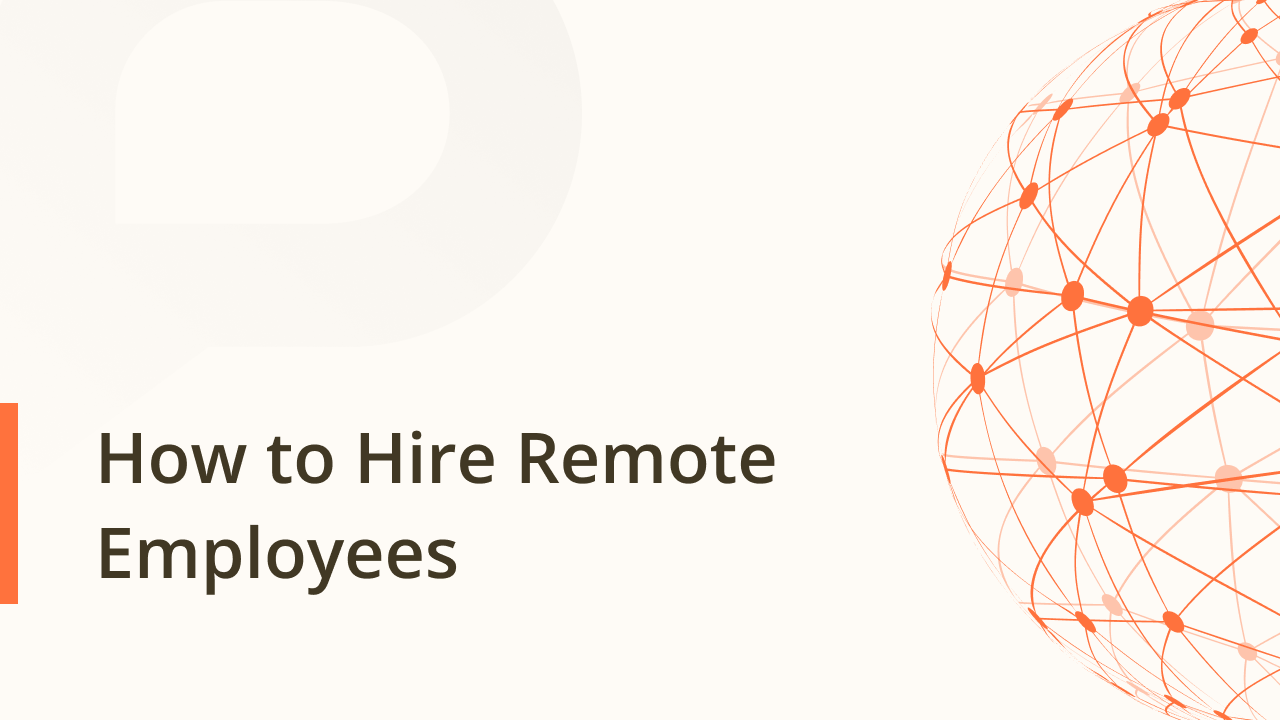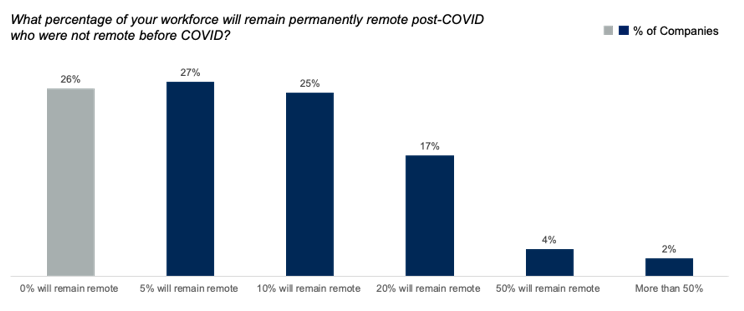Spending too much on recruitment, payroll or global HR?
We help you find the Best Providers at the lowest cost.
The paradigm shift toward remote work has solidified its role as an enduring facet of our work culture.
While the pandemic expedited the shift, compelling a significant portion of the workforce to adopt remote work for most of 2020 and a part of 2021, the move toward remote work was already underway. Organizations now realize that hiring remote employees is not only feasible but also advantageous. By eliminating geographical constraints on employment, businesses can tap into a global talent pool.
The Rise of Remote Employment
Gartner’s research underscores that a staggering 74% of companies are strategizing for a lasting transition toward various degrees of remote work.
This trend is supported by data from McKinsey, revealing that approximately 20-25% of workforces in advanced economies could effectively work remotely three to five days per week. This signifies a fourfold increase in remote work compared to the pre-pandemic era. Remote’s own research further validates these findings, highlighting that 81% of workers are open to relocating to a new region, state, or country, as long as it doesn’t jeopardize their careers.
A case in point is Siemens, the German conglomerate, which embraced a flexible work model, allowing thousands of its employees to work remotely.
Roland Busch, Deputy CEO and Labor Director of Siemens AG, stated,
“We’ve always had mobile working at Siemens, but now we’re taking it a step further. These changes will also be associated with a different leadership style, one that focuses on outcomes rather than on time spent at the office.”
The notion that the focus should be on results rather than hours spent at a physical desk is one of the compelling aspects of remote work. Instead of micromanaging employees’ desk time, supervisors can concentrate on measuring outputs, entrusting employees to accomplish their tasks independently.
Within this model, remote work empowers employees to manage their time according to their preferred work style. This flexibility often leads to improved team performance; for instance, it might enable quicker progress on projects or empower teams to deliver proactive customer service through a smart helpdesk integration.
Breaking Geographical Boundaries for Global Talent
The freedom from geographical limitations extends across borders. Building a remote team offers organizations the opportunity to tap into a global pool of talent for their open positions. With the elimination of physical office constraints, why confine your talent search to local candidates alone?
Benefits of Hiring Remote Employees
Historically, organizations were constrained by geographic proximity when filling vacant positions.
Recruitment efforts revolved around hiring candidates living in close proximity to the workplace or banking on the allure of the job to entice candidates to relocate. According to the U.S. Census Bureau, between 2019 and 2020, over 3.4 million individuals in the U.S. alone relocated to be nearer to new job prospects.
However, remote hiring transcends these limitations, expanding the talent pool from a localized sphere to a global panorama. Regardless of where exceptional candidates are located, they can now become integral members of your workforce.
The conventional approach posed limitations, particularly curbing diversity potential. Restricting recruitment to local talent inherently curtailed opportunities for diversity. In contrast, remote work is designed to be inclusive, enabling organizations to proactively source diverse candidates from around the world.
Consider the case of Tealbook, a supplier data platform, which doubled its workforce by embracing remote hiring in 2020 and 2021. Tealbook’s commitment to diversity was a driving factor in this decision. Stephany Lapierre, CEO of Tealbook, mentioned that they are intentional about maintaining diversity, particularly in roles like research and development. Their approach led to a 40% female composition in their R&D team.
Remote work also fosters a more equitable work environment, benefiting employees who face challenges in traditional office settings. Individuals with disabilities and caregivers, who have historically encountered obstacles in conventional workplaces, now find more accessible work options. By accommodating these dynamics, remote-first workplaces contribute to a more inclusive job landscape.
Not surprisingly, remote and flexible work arrangements have long been considered attractive perks by employees. Even before the pandemic in 2017, a significant 88% of employees considered flexible work time the most important benefit, while 80% valued the option to work from home most in a job, influencing their decisions on job offers.
Phil Perry, Head of EMEA North at Zoom said,
“With large numbers of workers ready to switch jobs if they aren’t offered the flexibility they need, businesses that fail to offer a choice on where and how their teams work could be walking into a trap. At a time when many organisations are under pressure to reduce costs while delivering more, being able to offer benefits like flexible working that require little additional investment is a simple way to keep teams happy and motivated.”
Hiring remote employees provides an immediate and evident boost to employee satisfaction and retention. Nonetheless, even in the midst of such positive transitions, challenges persist.
7 Factors to Consider When Hiring Remote Employees
Hiring remote employees might seem straightforward, but building a workplace that genuinely accommodates them requires dedicated effort. International borders continue to wield influence when it comes to payroll management, compliance with various employment regulations, and navigating taxation across multiple jurisdictions.
Each facet of hiring international employees presents its own complexities, especially for those new to remote hiring.
1. Navigating Payroll Complexities
Even in simple scenarios, payroll management can be challenging, particularly for small businesses with limited accounting resources. The complexities escalate when dealing with international payroll, as ensuring compliance with local regulations without breaching them becomes precarious.
Outsourcing international payroll management to an Employer of Record (EOR) is a prudent move, especially if establishing a foreign entity is not within your plans.
2. Deciding Compensation Structures
Determining how to compensate remote workers in various regions can be perplexing. Should their pay align with that of local employees? How does one determine equitable compensation in their region, considering factors such as the cost of living? While various compensation approaches exist, finding the right balance can be intricate.
3. Navigating Permanent Establishment Concerns
Cross-border taxation involves the concept of permanent establishment, indicating a continuous presence in a foreign country. Meeting the criteria for permanent establishment could subject your business to corporate tax obligations in that country. Adhering to distinct regulations and standards can be more complex than dealing with international counterparts.
5. Avoiding Misclassification of Employees
Misclassifying employees as contractors can lead to severe consequences, including legal disputes, penalties, and fines under local laws. It is imperative to classify job roles accurately and understand the nature of the employee’s relationship with your organization. This might involve transitioning some existing contractors to full-time employee status to mitigate risks.
You can use our free tool “Employees Misclassification Assessment“
6. Protecting IP and Invention Rights
Unlike traditional office setups, where intellectual property rights are relatively straightforward, remote arrangements introduce complexities. Remote employees might not work within the company premises, use company resources, or operate during standard company hours. Inadvertently compromising intellectual property rights due to unfamiliarity with international legal frameworks can lead to legal conflicts and reputational damage.
7. Managing Remote Workers’ Tax Liabilities
Coordinating income tax matters for a globally dispersed remote team while operating from a single country presents its own challenges. While not significantly more complex than managing taxes for a traditional workforce, limited resources tailored to remote contexts can complicate the process. Ensuring clarity on where remote workers are liable for taxes ensures compliance on their end and streamlines your processes.
Thankfully, the perceived complexities of these aspects are surmountable. Expert guidance from partners specializing in local employment laws is invaluable, facilitating recruitment, risk management, and efficient scalability.
Hiring Remote Employees Best Practice
In many ways, the process of hiring remote employees, whether local or international, mirrors the approach for hiring on-site staff. However, throughout the hiring and onboarding journey, there’s a heightened focus on aligning roles with remote execution.
Crafting a Compelling Job Posting
A well-defined job description and a thorough understanding of how the role translates to remote work are essential. Consider the platforms where the job posting will appear and tailor the benefits and compensation to resonate with potential candidates in those regions. Understand the expectations of the audience and provide comprehensive information about the job.
Conducting Effective Interviews
Advance planning for interview logistics and technological tools is crucial. While video conferencing is commonplace, ensure accessibility for all participants. Also, adapt the interview process to accommodate different time zones, making it convenient for all parties involved.
Prioritizing Communication
Open and transparent communication is paramount when collaborating with remote teams. Clearly communicate your expectations to applicants, delve into their experiences, and acknowledge the diversity of qualifications across various regions. Provide comprehensive insights into the job, remote team dynamics, and expected contributions. Recognize that candidates might perceive remote and international employment as a risk, so address their queries promptly.
Streamlined Onboarding
Given geographical dispersion and time zone variations, a cohesive onboarding process is vital. Effective training programs and streamlined legal documentation are key components. This is an area where seeking external expertise can be beneficial.
Hiring with an EOR (Employer of Record)
At this juncture, enlisting the support of an Employer of Record (EOR) is indispensable. Attempting to navigate international payroll, taxation nuances, and legal intricacies independently can lead to compliance issues and penalties.
Choosing the right partner is paramount. There are two primary categories of global employment solutions providers: those with owned legal entities in target countries and those relying on partner networks. While some providers combine owned entities and partner networks, the superior choice is partnering with an owned-entity EOR. Owned-entity EORs have legal establishments in the hiring country, ensuring comprehensive compliance and tailored services.
Furthermore, distinguishing between Professional Employer Organizations (PEOs) and EORs is essential. While PEOs can offer HR support, not all provide comprehensive EOR services. An EOR legally employs international workers on your behalf, allowing you to manage day-to-day operations while ensuring legal compliance.
Minimizing the Risks of Hiring Remote Employees
To foster alignment and engagement in globally distributed teams, proactive measures are needed. Hybrid models can inadvertently lead to isolation, burnout, and reduced productivity. To mitigate these risks, companies must be mindful of common pitfalls encountered during the transition to remote work.
Cultivating an Inclusive Culture
Unless intentional efforts are made to foster a remote-first culture, remote employees may feel marginalized in comparison to their on-site counterparts. Ensuring inclusion requires creating opportunities for remote team members to participate in bonding activities and benefits traditionally associated with in-person work environments.
Effective Communication
Remote collaboration hinges on effective communication. The digital medium can lead to misinterpretation, especially in cases of linguistic or cultural differences. Successful remote teams prioritize thorough documentation, enabling seamless collaboration across different time zones.
Anticipating Remote Workforce Needs
Proactive consideration of remote employees’ needs fosters alignment and engagement, contributing to talent retention. Facilitating flexible work arrangements benefits individuals with disabilities and caregivers who may face challenges in traditional workplaces.
Sustaining a Remote-first Culture
As your remote-first culture evolves, ensure that your tools and practices align with your growth trajectory. Cultivating a sense of unity, irrespective of geographic locations, enhances collaboration and innovation.
Fostering Global Team Collaboration
Encourage cross-functional collaboration to break down silos. Collaboration across departments enhances outcomes and innovation, minimizes barriers, and strengthens team cohesion.
Laying the Foundation During Onboarding
Onboarding shapes your remote culture. Reinforce communication norms and standards during onboarding, providing new hires with accessible resources. Pairing newcomers with buddies in similar time zones fosters inclusivity and support.
Start Hiring Remote Employees
Commencing the process of hiring remote team members, particularly those located beyond national borders, may appear overwhelming. Concerns about risk, initiation complexities, compliance, taxes, and expenditures are valid. However, venturing into international hiring is not only feasible but also streamlined with the support of an EOR.



